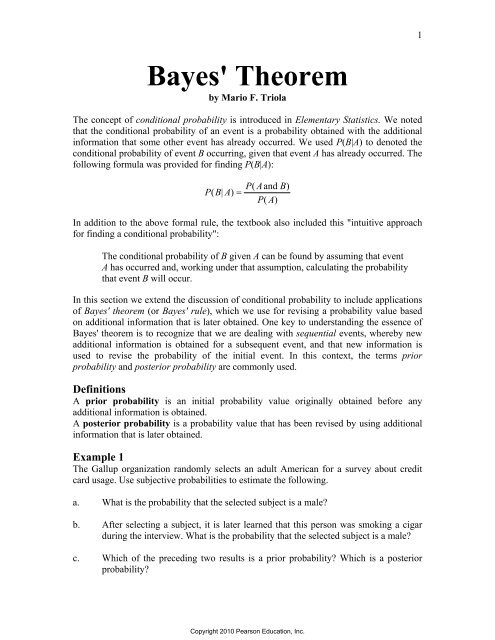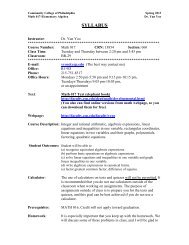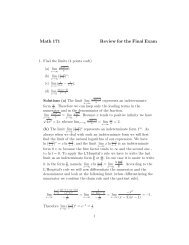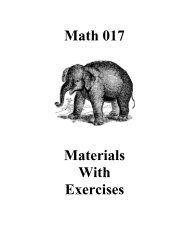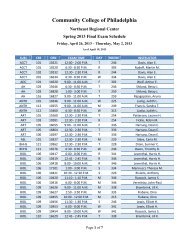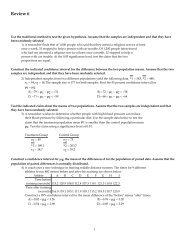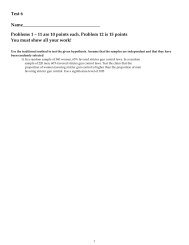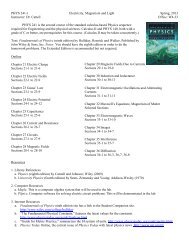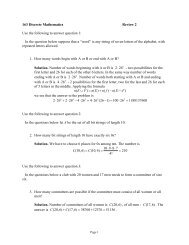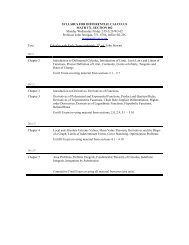Bayes' Theorem
Bayes' Theorem
Bayes' Theorem
- No tags were found...
Create successful ePaper yourself
Turn your PDF publications into a flip-book with our unique Google optimized e-Paper software.
1<strong>Bayes'</strong> <strong>Theorem</strong>by Mario F. TriolaThe concept of conditional probability is introduced in Elementary Statistics. We notedthat the conditional probability of an event is a probability obtained with the additionalinformation that some other event has already occurred. We used P(B|A) to denoted theconditional probability of event B occurring, given that event A has already occurred. Thefollowing formula was provided for finding P(B|A):PBA ( | ) =P( AandB)P( A)In addition to the above formal rule, the textbook also included this "intuitive approachfor finding a conditional probability":The conditional probability of B given A can be found by assuming that eventA has occurred and, working under that assumption, calculating the probabilitythat event B will occur.In this section we extend the discussion of conditional probability to include applicationsof <strong>Bayes'</strong> theorem (or <strong>Bayes'</strong> rule), which we use for revising a probability value basedon additional information that is later obtained. One key to understanding the essence of<strong>Bayes'</strong> theorem is to recognize that we are dealing with sequential events, whereby newadditional information is obtained for a subsequent event, and that new information isused to revise the probability of the initial event. In this context, the terms priorprobability and posterior probability are commonly used.DefinitionsA prior probability is an initial probability value originally obtained before anyadditional information is obtained.A posterior probability is a probability value that has been revised by using additionalinformation that is later obtained.Example 1The Gallup organization randomly selects an adult American for a survey about creditcard usage. Use subjective probabilities to estimate the following.a. What is the probability that the selected subject is a male?b. After selecting a subject, it is later learned that this person was smoking a cigarduring the interview. What is the probability that the selected subject is a male?c. Which of the preceding two results is a prior probability? Which is a posteriorprobability?Copyright 2010 Pearson Education, Inc.
2Solutiona. Roughly half of all Americans are males, so we estimate the probability ofselecting a male subject to be 0.5. Denoting a male by M, we can express thisprobability as follows: P(M) = 0.5.b. Although some women smoke cigars, the vast majority of cigar smokers aremales. A reasonable guess is that 85% of cigar smokers are males. Based on thisadditional subsequent information that the survey respondent was smoking acigar, we estimate the probability of this person being a male as 0.85. Denoting amale by M and denoting a cigar smoker by C, we can express this result asfollows: P(M | C) = 0.85.c. In part (a), the value of 0.5 is the initial probability, so we refer to it as the priorprobability. Because the probability of 0.85 in part (b) is a revised probabilitybased on the additional information that the survey subject was smoking a cigar,this value of 0.85 is referred to a posterior probability.The Reverend Thomas Bayes [1701 (approximately) − 1761] was an Englishminister and mathematician. Although none of his work was published during hislifetime, later (posterior?) publications included the following theorem (or rule) that hedeveloped for determining probabilities of events by incorporating information aboutsubsequent events.<strong>Bayes'</strong> <strong>Theorem</strong>The probability of event A, given that event B has subsequently occurred, isP( A) ⋅ P( B| A)P( A| B)=[ P( A) ⋅ P( B| A)] + [ P( A) ⋅P( B| A)]That's a formidable expression, but we will simplify its calculation. See the followingexample, which illustrates use of the above expression, but also see the alternativemethod based on a more intuitive application of <strong>Bayes'</strong> theorem.Example 2In Orange County, 51% of the adults are males. (It doesn't take too much advancedmathematics to deduce that the other 49% are females.) One adult is randomly selectedfor a survey involving credit card usage.a. Find the prior probability that the selected person is a male.b. It is later learned that the selected survey subject was smoking a cigar. Also, 9.5%of males smoke cigars, whereas 1.7% of females smoke cigars (based on datafrom the Substance Abuse and Mental Health Services Administration). Use thisadditional information to find the probability that the selected subject is a male.Copyright 2010 Pearson Education, Inc.
3SolutionLet's use the following notation:M = maleM = female (or not male)C = cigar smoker C = not a cigar smoker.a. Before using the information given in part b, we know only that 51% of the adultsin Orange County are males, so the probability of randomly selecting an adult andgetting a male is given by P(M) = 0.51.b. Based on the additional given information, we have the following:P(M) = 0.51because 51% of the adults are malesP( M ) = 0.49 because 49% of the adults are females (not males)P(C|M) = 0.095P(C| M ) = 0.017.because 9.5% of the males smoke cigars (That is,the probability of getting someone who smokescigars, given that the person is a male, is 0.095.)because 1.7% of the females smoke cigars (That is,the probability of getting someone who smokescigars, given that the person is a female, is 0.017.)Let's now apply <strong>Bayes'</strong> theorem by using the preceding formula with M in placeof A, and C in place of B. We get the following result:P(M | C) ==P( M) ⋅ P( C| M)[ P( M) ⋅ P( C| M)] + [ P( M) ⋅P( C| M)]051 . ⋅0.095[. 0 51⋅ 0. 095] + [. 0 49⋅0. 017]= 0.85329341= 0.853 (rounded)Before we knew that the survey subject smoked a cigar, there is a 0.51 probabilitythat the survey subject is male (because 51% of the adults in Orange County aremales). However, after learning that the subject smoked a cigar, we revised theprobability to 0.853. There is a 0.853 probability that the cigar−smokingrespondent is a male. This makes sense, because the likelihood of a maleincreases dramatically with the additional information that the subject smokescigars (because so many more males smoke cigars than females).Copyright 2010 Pearson Education, Inc.
4Intuitive Bayes <strong>Theorem</strong>The preceding solution illustrates the application of <strong>Bayes'</strong> theorem with its calculationusing the formula. Unfortunately, that calculation is complicated enough to create anabundance of opportunities for errors and/or incorrect substitution of the involvedprobability values. Fortunately, here is another approach that is much more intuitive andeasier:Assume some convenient value for the total of all items involved, thenconstruct a table of rows and columns with the individual cell frequenciesbased on the known probabilities.For the preceding example, simply assume some value for the adult population ofOrange County, such as 100,000, then use the given information to construct a table, suchas the one shown below.Finding the number of males who smoke cigars: If 51% of the 100,000 adults aremales, then there are 51,000 males. If 9.5% of the males smoke cigars, then the numberof cigar−smoking males is 9.5% of 51,000, or 0.095 × 51,000 = 4845. See the entry of4845 in the table. The other males who do not smoke cigars must be 51,000 − 4845 =46,155. See the value of 46,155 in the table.Finding the number of females who smoke cigars: Using similar reasoning, 49%of the 100,000 adults are females, so the number of females is 49,000. Given that 1.7% ofthe females smoke cigars, the number of cigar−smoking females is 0.017 × 49,000 =833. The number of females who do not smoke cigars is 49,000 − 833 = 48,167. See theentries of 833 and 48,167 in the table.CCTotal(Cigar Smoker) (Not a Cigar Smoker)M (male) 4845 46,155 51,000M (female) 833 48,167 49,000Total 5678 94,322 100,000The above table involves relatively simple arithmetic. Simply partition theassumed population into the different cell categories by finding suitable percentages.Now we can easily address the key question as follows: To find the probability ofgetting a male subject, given that the subject smokes cigars, simply use the sameconditional probability described in the textbook. To find the probability of getting amale given that the subject smokes, restrict the table to the column of cigar smokers, thenfind the probability of getting a male in that column. Among the 5678 cigar smokers,there are 4845 males, so the probability we seek is 4845/5678 = 0.85329341. That is,P(M | C) = 4845/5678 = 0.85329341 = 0.853 (rounded).Copyright 2010 Pearson Education, Inc.
5<strong>Bayes'</strong> <strong>Theorem</strong> GeneralizedThe preceding formula for <strong>Bayes'</strong> theorem and the preceding example use exactly twocategories for event A (male and female), but the formula can be extended to includemore than two categories. The following example illustrates this extension and it alsoillustrates a practical application of <strong>Bayes'</strong> theorem to quality control in industry. Whendealing with more than the two events of A and A , we must be sure that the multipleevents satisfy two important conditions:1. The events must be disjoint (with no overlapping).2. The events must be exhaustive, which means that they combine to includeall possibilities.Example 3An aircraft emergency locator transmitter (ELT) is a device designed to transmit a signalin the case of a crash. The Altigauge Manufacturing Company makes 80% of the ELTs,the Bryant Company makes 15% of them, and the Chartair Company makes the other5%. The ELTs made by Altigauge have a 4% rate of defects, the Bryant ELTs have a 6%rate of defects, and the Chartair ELTs have a 9% rate of defects (which helps to explainwhy Chartair has the lowest market share).a. If an ELT is randomly selected from the general population of all ELTs, find theprobability that it was made by the Altigauge Manufacturing Company.b. If a randomly selected ELT is then tested and is found to be defective, find theprobability that it was made by the Altigauge Manufacturing Company.SolutionWe use the following notation:A = ELT manufactured by AltigaugeB = ELT manufactured by BryantC = ELT manufactured by ChartairD = ELT is defectiveD = ELT is not defective (or it is good)a. If an ELT is randomly selected from the general population of all ELTs, theprobability that it was made by Altigauge is 0.8 (because Altigauge manufactures80% of them).b. If we now have the additional information that the ELT was tested and was foundto be defective, we want to revise the probability from part (a) so that the newinformation can be used. We want to find the value of P(A|D), which is theprobability that the ELT was made by the Altigauge company given that it isdefective. Based on the given information, we know these probabilities:Copyright 2010 Pearson Education, Inc.
6P(A) = 0.80P(B) = 0.15P(C) = 0.05P(D|A) = 0.04P(D|B) = 0.06P(D|C) = 0.09because Altigauge makes 80% of the ELTsbecause Bryant makes 15% of the ELTsbecause Chartair makes 5% of the ELTsbecause 4% of the Altigauge ELTs are defectivebecause 6% of the Bryant ELTs are defectivebecause 9% of the Chartair ELTs are defectiveHere is <strong>Bayes'</strong> theorem extended to include three events corresponding to theselection of ELTs from the three manufacturers (A, B, C):P(A|D) ==P( A) ⋅ P( D| A)[ PA ( ) ⋅ PDA ( | )] + [ PB ( ) ⋅ PDB ( | )] + [ PC ( ) ⋅PDC( | )]080 . ⋅004.[. 080⋅ 0. 04] + [. 015⋅ 0. 06] + [. 0 05⋅0. 09]= 0.703 (rounded)Intuitive Baye's <strong>Theorem</strong>: Now let's find P(A|D) by using a table. Let's arbitrarilyassume that 10,000 ELTs were manufactured. (The solution doesn't depend on thenumber selected, but it's helpful to select a number large enough so that the cellsin the table are all whole numbers.) Because 80% of the ELTs are made byAltigauge, we have 8000 ELTs made by Altigauge, and 4% of them (or 320) aredefective. Also, if 320 of the Altigauge ELTs are defective, the other 7680 are notdefective. See the values of 320 and 7680 in the table below. The other values arefound using the same reasoning.D (defective) D (not defective) TotalA (Altigauge) 320 7680 8,000B (Bryant) 90 1410 1,500C (Chartair) 45 455 500Total 455 9545 10,000We want to find the probability that an ELT was made by Altigauge, giventhat it is known to be defective. Because we know the condition that the ELT isdefective, we can refer to the first column of values where we see that among the455 total defective ELTs, 320 were made by Altigauge, so that the probability is320/455 = 0.703 (rounded). This is the same result obtained with the formulafrom <strong>Bayes'</strong> theorem.The preceding example involve an extension of <strong>Bayes'</strong> theorem to threeevents denoted by A, B, C. Based on the format of the formula used in thesolution, it is easy to extend <strong>Bayes'</strong> theorem so that it can be used with four ormore events. (See Exercises 11 and 12.)Copyright 2010 Pearson Education, Inc.
7ExercisesPregnancy Test Results. In Exercises 1 and 2, refer to the results summarized in thetable below.Positive Test Result(Pregnancy is indicated)Negative Test Result(Pregnancy is not indicated)Subject is Pregnant 80 5Subject is Not Pregnant 3 111. a. If one of the 99 test subjects is randomly selected, what is the probability ofgetting a subject who is pregnant?b. A test subject is randomly selected and is given a pregnancy test. What is theprobability of getting a subject who is pregnant, given that the test result ispositive?2. a. One of the 99 test subjects is randomly selected. What is the probability of gettinga subject who is not pregnant?b. A test subject is randomly selected and is given a pregnancy test. What is theprobability of getting a subject who is not pregnant, given that the test result isnegative?3. Survey Results In Orange County, 51% of the adults are males. One adult israndomly selected for a survey involving credit card usage. (See Example 2 in thissection.)a. Find the prior probability that the selected person is a female.b. It is later learned that the selected survey subject was smoking a cigar. Also, 9.5%of males smoke cigars, whereas 1.7% of females smoke cigars (based on datafrom the Substance Abuse and Mental Health Services Administration). Use thisadditional information to find the probability that the selected subject is a female.4. Emergency Locator Transmitters An aircraft emergency locator transmitter(ELT) is a device designed to transmit a signal in the case of a crash. TheAltigauge Manufacturing Company makes 80% of the ELTs, the BryantCompany makes 15% of them, and the Chartair Company makes the other 5%.The ELTs made by Altigauge have a 4% rate of defects, the Bryant ELTs have a6% rate of defects, and the Chartair ELTs have a 9% rate of defects. (These arethe same results from Example 3 in this section.)a. Find the probability of randomly selecting an ELT and getting one manufacturedby the Bryant Company.b. If an ELT is randomly selected and tested, find the probability that it wasmanufactured by the Bryant Company if the test indicates that the ELT isdefective.5. Emergency Locator Transmitters Use the same ELT data from Exercise 4.a. Find the probability of randomly selecting an ELT and getting one manufacturedby the Chartair Company.b. An ELT is randomly selected and tested. If the test indicates that the ELT isdefective, find the probability that it was manufactured by the Chartair Company.Copyright 2010 Pearson Education, Inc.
86. Emergency Locator Transmitters Use the same ELT data from Exercise 4. AnELT is randomly selected and tested. If the test indicates that the ELT is notdefective, find the probability that it is from the Altigauge Company.7. Pleas and Sentences In a study of pleas and prison sentences, it is found that45% of the subjects studied were sent to prison. Among those sent to prison, 40%chose to plead guilty. Among those not sent to prison, 55% chose to plead guilty.a. If one of the study subjects is randomly selected, find the probability of gettingsomeone who was not sent to prison.b. If a study subject is randomly selected and it is then found that the subject entereda guilty plea, find the probability that this person was not sent to prison.8. Pleas and Sentences Use the same data given in Exercise 7.a. If one of the study subjects is randomly selected, find the probability of gettingsomeone who was sent to prison.b. If a study subject is randomly selected and it is then found that the subject entereda guilty plea, find the probability that this person was sent to prison.9. HIV The New York State Health Department reports a 10% rate of the HIV virusfor the “at-risk” population. Under certain conditions, a preliminary screening testfor the HIV virus is correct 95% of the time. (Subjects are not told that they areHIV infected until additional tests verify the results.) If someone is randomlyselected from the at-risk population, what is the probability that they have theHIV virus if it is known that they have tested positive in the initial screening?10. HIV Use the same data from Exercise 9. If someone is randomly selected fromthe at-risk population, what is the probability that they have the HIV virus if it isknown that they have tested negative in the initial screening?11. Extending <strong>Bayes'</strong> <strong>Theorem</strong> Example 3 in this section included an extension of<strong>Bayes'</strong> theorem to include three events, denoted by A, B, C. Write an expressionthat extends <strong>Bayes'</strong> theorem so that it can be used to find P(A|Z), assuming thatthe initial event can occur in one of four ways: A, B, C, D.12. Extensions of <strong>Bayes'</strong> <strong>Theorem</strong> In Example 2, we used only the initial events ofA and A . In Example 3, we used initial events of A, B, and C. If events B and Cin Example 3 are combined and denoted as A , we can find P(A|D) using thesimpler format of <strong>Bayes'</strong> theorem given in Example 2. How would the resultingvalue of P(A|D) in Example 3 be affected by using this simplified approach?13. Biased Coin In an article about confusion of eye witnesses, John Allen Pauloscites the problem of three coins, one of which is biased so that it turns up heads75% of the time. If you randomly select one of the coins, toss it three times, andobtain three heads, what is the probability that this is the biased coin?Copyright 2010 Pearson Education, Inc.
9Answers to Odd−Numbered Exercises1. a. 85/99 or 0.859b. 80/83 or 0.9643. a. 0.49b. 0.1475. a. 0.05b. 0.09897. a. 0.55b. 0.6279. 0.67911. P(A|Z) =P( A) ⋅ P( Z| A)[ PA ( ) ⋅ PZA ( | )] + [ PB ( ) ⋅ PZB ( | )] + [ PC ( ) ⋅ PZC ( | )] + [ PD ( ) ⋅PZD( | )]13. 0.628Copyright 2010 Pearson Education, Inc.


